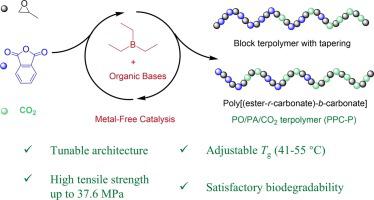Journal of CO2 Utilization ( IF 7.2 ) Pub Date : 2021-05-01 , DOI: 10.1016/j.jcou.2021.101558 Jiaxin Liang , Shuxian Ye , Wenjing Wang , Congxiao Fan , Shuanjin Wang , Dongmei Han , Wei Liu , Yan Cui , Limin Hao , Min Xiao , Yuezhong Meng

|
Bulk terpolymerization of carbon dioxide and phthalic anhydride with propylene oxide is successfully carried out using metal-free and economical Lewis pairs under mild conditions. A series of commercial organic bases are coupled with triethyl borane (TEB) as Lewis pairs to optimize the activity and the results show that the TEB/ bis(triphenylphosphine)iminium chloride (PPNCl) pair exhibits relatively high activity and selectivity. The impact of the molar ratio of TEB to organic bases, reaction temperature and CO2 pressure as well as the catalyst loading on the activity and selectivity of the copolymerization are investigated. Particularly, the turnover frequency reaches 164 h−1 with a TEB/PPNCl molar ratio of 2/1 at 80 °C. To our delight, the poly(ester-co-carbonate)s with random or block structures can be simply tuned by choosing different organic bases coupled with TEB. In these cases, the resultant terpolymers with comprehensive properties can be readily synthesized. As expected, the incorporation of phthalic anhydride effectively modifies the thermal and mechanical properties of commercial poly(propylene carbonate) (PPC). Terpolymers named as PPC-P with 43 mol% aromatic polyester moieties displays a glass transition temperature (Tg) of 47 °C, about 9 °C higher than that of commercial PPC, and gives a tensile strength higher than 37.6 MPa. To our delight, the synthesized PPC-P exhibits satisfactory degradation speed under standard composting condition compared with commercial PBAT and PPC.
中文翻译:

使用路易斯酸碱双催化剂由二氧化碳,邻苯二甲酸酐和环氧丙烷合成的性能可调节的三元共聚物
使用不含金属且经济的路易斯对在温和条件下成功进行了二氧化碳和邻苯二甲酸酐与环氧丙烷的本体三元聚合。一系列商业有机碱与三乙基硼烷(TEB)作为路易斯对偶合以优化活性,结果表明TEB /双(三苯基膦)亚胺氯化物(PPNCl)对表现出较高的活性和选择性。研究了TEB与有机碱的摩尔比,反应温度和CO 2压力以及催化剂用量对共聚活性和选择性的影响。特别地,在80℃下,当TEB / PPNCl摩尔比为2/1时,周转频率达到164h -1。我们高兴地看到,聚(酯共通过选择与TEB结合的不同有机碱,可以简单地调整具有无规或嵌段结构的碳酸根。在这些情况下,可以容易地合成得到的具有综合性能的三元共聚物。如所期望的,邻苯二甲酸酐的掺入有效地改变了商业聚碳酸亚丙酯(PPC)的热和机械性能。具有43 mol%芳族聚酯部分的名为PPC-P的三元共聚物的玻璃化转变温度(T g)为47°C,比商用PPC高约9°C,拉伸强度高于37.6 MPa。令我们高兴的是,与标准PBAT和PPC相比,在标准堆肥条件下,合成的PPC-P表现出令人满意的降解速度。











































 京公网安备 11010802027423号
京公网安备 11010802027423号